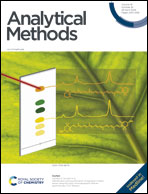PCB-C4D coupled with paper-based microfluidic sampling for the rapid detection of liquid conductivity†
Abstract
The detection of liquid electrical conductivity has board applications in food safety testing, water quality monitoring, and agricultural soil analysis. Electrodes used in traditional liquid electrical conductivity detection come into direct contact with liquid, leading to electrode contamination and affecting the accuracy of the detection results. The capacitively coupled contactless conductivity detection (C4D) method effectively addresses this issue. However, impurity particles present in the solution can compromise the consistency and repeatability of detection results. This study combines paper-based microfluidic technology with printed circuit board-capacitively coupled contactless conductivity detection (PCB-C4D) to address this issue. Prior to sample detection, in situ rapid filtration is employed to remove impurity particles from the raw solution sample, significantly enhancing detection consistency and reliability. Simultaneously, Optimization of PCB-C4D parameters, channel size, filtration time, and solution drop rate ensures optimal detection conditions. A compact kit design facilitates reliable assembly of the PCB-C4D electrodes and paper-based channel, enhancing practicality. Practical measurements on the conductivity of orange juice, cucumber, and soil solution further validate the method's accuracy, rapidity, and effectiveness in in situ conductivity detection. This work advances the practical application of PCB-C4D technology.



 Please wait while we load your content...
Please wait while we load your content...